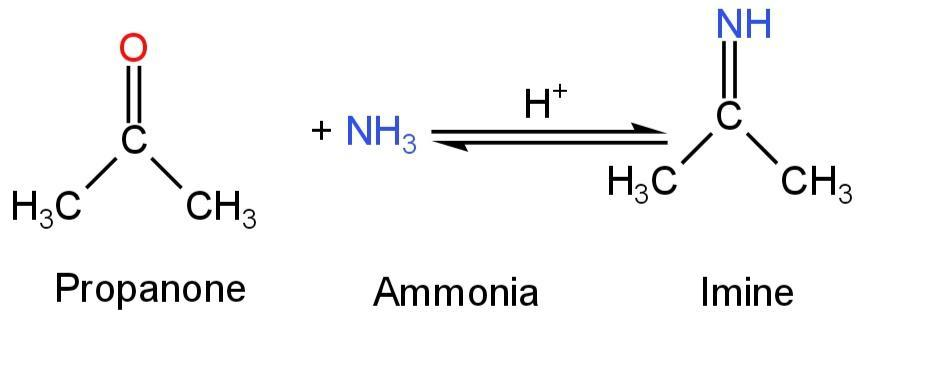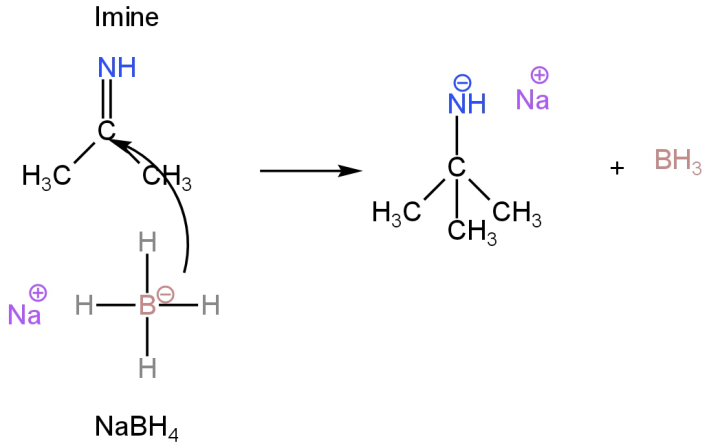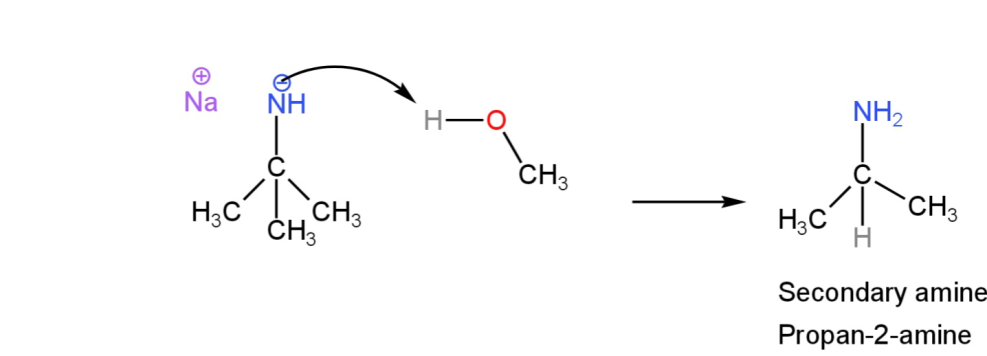
Can Sodium borohydride (NaBH4) reduce imine?
Answer
222.9k+ views
Hint: Sodium borohydride is a good reducing agent. It can reduce aldehydes and ketones into primary alcohols and secondary alcohols respectively.
Complete Step by Step Solution:
When ammonia is treated with aldehydes or ketones, the ammonia group gets added to the carbonyl group of aldehydes or ketones.
This is a reversible reaction and acid is used as a catalyst.
The product formed is called imine.

Image: Reaction of propanone with ammonia
Sodium borohydride is a good reducing agent that can reduce imines into secondary amines.
This reaction happens in the presence of alumina.
Here polar metal-hydrogen bond furnishes the hydride anion.
The mechanism of the reaction is of two steps.
Step-1
Nucleophilic attack by the hydride anion.

Image: Attack of the nucleophile
Step-2
Protonation leads to the formation of a secondary amine.

Image: Protonation in the presence of methanol.
Additional Information: Sodium borohydride is a lesser reducing agent than Lithium aluminium hydride. It can reduce aldehydes to primary alcohol and ketones, and acid chlorides to secondary alcohols. It cannot reduce esters, amides, acids, nitriles etc.
Note: Sodium borohydride is an inorganic compound and is a good reducing agent due to the existence of a polar metal-hydrogen bond. The hydrogen atom in the compound acts as a hydride and adds to the carbonyl carbon. The extremely familiar reducing agents in organic chemistry are lithium aluminium hydride and sodium borohydride. It is to be noted that the hydride anion does not directly exist during this reaction, rather a metal-hydrogen bond provides the hydride anion. This anion then acts as a nucleophile.
Complete Step by Step Solution:
When ammonia is treated with aldehydes or ketones, the ammonia group gets added to the carbonyl group of aldehydes or ketones.
This is a reversible reaction and acid is used as a catalyst.
The product formed is called imine.

Image: Reaction of propanone with ammonia
Sodium borohydride is a good reducing agent that can reduce imines into secondary amines.
This reaction happens in the presence of alumina.
Here polar metal-hydrogen bond furnishes the hydride anion.
The mechanism of the reaction is of two steps.
Step-1
Nucleophilic attack by the hydride anion.

Image: Attack of the nucleophile
Step-2
Protonation leads to the formation of a secondary amine.

Image: Protonation in the presence of methanol.
Additional Information: Sodium borohydride is a lesser reducing agent than Lithium aluminium hydride. It can reduce aldehydes to primary alcohol and ketones, and acid chlorides to secondary alcohols. It cannot reduce esters, amides, acids, nitriles etc.
Note: Sodium borohydride is an inorganic compound and is a good reducing agent due to the existence of a polar metal-hydrogen bond. The hydrogen atom in the compound acts as a hydride and adds to the carbonyl carbon. The extremely familiar reducing agents in organic chemistry are lithium aluminium hydride and sodium borohydride. It is to be noted that the hydride anion does not directly exist during this reaction, rather a metal-hydrogen bond provides the hydride anion. This anion then acts as a nucleophile.
Recently Updated Pages
JEE General Topics in Chemistry Important Concepts and Tips

JEE Extractive Metallurgy Important Concepts and Tips for Exam Preparation

JEE Atomic Structure and Chemical Bonding important Concepts and Tips

JEE Amino Acids and Peptides Important Concepts and Tips for Exam Preparation

Electricity and Magnetism Explained: Key Concepts & Applications

JEE Energetics Important Concepts and Tips for Exam Preparation

Trending doubts
JEE Main 2026: Application Form Open, Exam Dates, Syllabus, Eligibility & Question Papers

Derivation of Equation of Trajectory Explained for Students

Hybridisation in Chemistry – Concept, Types & Applications

Understanding the Angle of Deviation in a Prism

How to Convert a Galvanometer into an Ammeter or Voltmeter

Degree of Dissociation: Meaning, Formula, Calculation & Uses

Other Pages
NCERT Solutions For Class 11 Chemistry Chapter 7 Redox Reaction

JEE Advanced Marks vs Ranks 2025: Understanding Category-wise Qualifying Marks and Previous Year Cut-offs

Hydrocarbons Class 11 Chemistry Chapter 9 CBSE Notes - 2025-26

Thermodynamics Class 11 Chemistry Chapter 5 CBSE Notes - 2025-26

NCERT Solutions ForClass 11 Chemistry Chapter Chapter 5 Thermodynamics

Equilibrium Class 11 Chemistry Chapter 6 CBSE Notes - 2025-26




